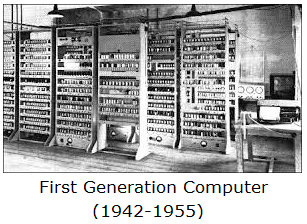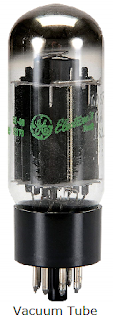The word computer has come from the word compute that means calculating. Thus from this point of view we can define a computer as an electronic device which performs mathematical operations at high rate.
The main objective of inventing the computer was to process a large number of calculation. But nowadays, a computer is also being used to process non-mathematical data along with mathematical data. Hence to define a computer merely as calculating device is to ignore its rest of the work. More accurately, a computer system can be defined as a man made electronic machine which can operate on a large amount of data or information.
Here data or information can be either numerical or non-numerical and it can be of any size. Example of non-numerical data can be a list of bio-data, results of many students, details of a person while booking ticket on airline or railways reservation. A computer can store, read and process data and produce a meaningful data as output. It works very fast and does not make any mistake.
Computer Generations:
The term generation is used to distinguish between varying hardware and software technologies. There are five computer generations known till today. Each generation of computers has its advantages and disadvantages.
First Generation Computer:
The computers developed during 1942 to 1955 were called first generation computer. ENIAC (Electronic Numerical Integrator And Computer), EDVAC (Electronic Discrete Variable Automatic Computer), and EDSAC ( Electronic Delay Storage Automatic Calculator ) are the name of first generation computer.
These machines and other of their time were designed using vacuum tubes. A vacuum tube was a fragile glass which could control and amplify electrical signals. The first generation computer was operated on machine languages.
Advantages of First Generation Computer:
- Vacuum tubes were the only electronic components available during that time.
- Vacuum tube technology made possible to the invention of digital computers.
- First generation computers were the fastest calculating machine of their time.
- The computation time of these computers were in milliseconds.
Disadvantages of First Generation Computer:
- First generation computers were huge in size.
- They were not completely reliable.
- They need air conditioning because thousands of vacuum tubes generate a large amount of heat.
- Hardware failures were occurred frequently.
- They were non-portable.
- Their commercial use was limited because their production was difficult and costly.
- They needed continuous maintenance.
- Manual assembly of individual components was required.
Second Generation Computer:
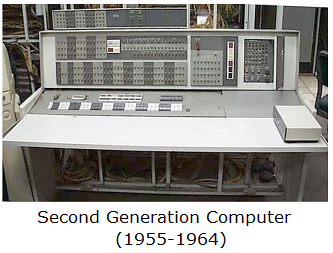 The computers developed during 1955 to 1964 were called the second Generation of computer. These second generation computers were designed using transistors in place of vacuum tubes after their invention. However computers that used transistor were not produced in quantity until over a decade later. Transistor were the brain of the second generation computers.
The computers developed during 1955 to 1964 were called the second Generation of computer. These second generation computers were designed using transistors in place of vacuum tubes after their invention. However computers that used transistor were not produced in quantity until over a decade later. Transistor were the brain of the second generation computers. In the second generation of computer transistors were used because they were smaller in size and more reliable than the vacuum tubes. And also they consume less power and generate less heat as compared to vacuum tubes. They were operated on assembly languages.
Advantages of Second Generation Computer:
- They were smaller in size as compared to first generation computers.
- They were more reliable than first generation computers.
- They consume less power and produce less heat than that of first generation computers.
- These computers can perform computation tasks in microseconds.
- Hardware failure was decreased as there were in first generation computers.
- They could be taken from one place to another.
- Their commercial use was wider than that of first generation computers.
Disadvantages of Second Generation Computer:
- As the first generation computers needed air conditioning, second generation computers also needed air conditioning.
- Frequent maintenance was required.
- Manual assembly of individual component into functioning was still required.
- Its commercial production was difficult and costly.
Third Generation Computer:
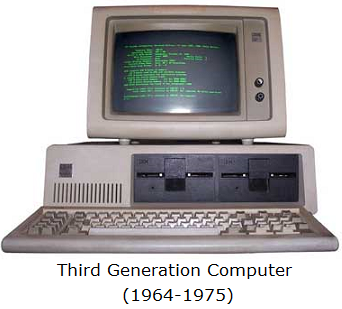 The computers designed during 1964 to 1975 were regarded as the third generation computers. These computers were designed using IC (Integrated Circuits).
The computers designed during 1964 to 1975 were regarded as the third generation computers. These computers were designed using IC (Integrated Circuits). With advancement in electronic technology with time resulted with the technology of microelectronics. With the help of microelectronic technology it made possible to integrate a large number of circuit components into a single and very small piece of silicon which was known as chips. And this technology is called Integrated circuit or IC. This small chip contained several transistors in it.
Third generation computers are operated on structured programming languages. Structured programming languages are C, FORTRAN AND Pascal.
Advantages of Third Generation Computer:
- With the invention of IC third generation computers are smaller than previous generation computers.
- They were more reliable than second generation computers.
- They generate less heat and consume less power than second generation computers.
- The computation time in this generation was reduced from microsecond to nanosecond.
- Maintenance cost was low because hardware failure rarely occurred.
- Third generation computers were portable.
- They were used widely in various commercial applications all over the world.
- Manual assembly of individual components was not required in this generation.
- Commercial production was easier and cheaper.
Disadvantage of Third Generation Computer:
- Air conditioning was still required in many cases.
- Highly sophisticated technology required for the manufacturing of IC chips.
Fourth Generation Computer:
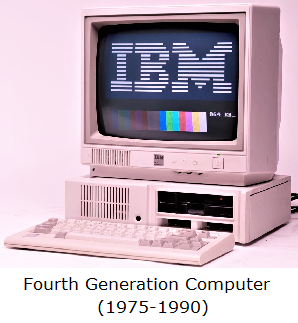 The computers developed during 1975 to 1990 are regarded as fourth generation computers. Initially, an IC (Integrated Circuit) could have only about 10 to 20 components in it and this technology is known as small scale integration. Later, with the advancement of technology it became possible to integrate more than 100 components in a single chip and this technology is known as medium scale integration. Then came the era of LSI (Large Scale Integration) and VLSI (Very Large Scale Integration), these technology could integrate more than 30000 component into a single chip.
The computers developed during 1975 to 1990 are regarded as fourth generation computers. Initially, an IC (Integrated Circuit) could have only about 10 to 20 components in it and this technology is known as small scale integration. Later, with the advancement of technology it became possible to integrate more than 100 components in a single chip and this technology is known as medium scale integration. Then came the era of LSI (Large Scale Integration) and VLSI (Very Large Scale Integration), these technology could integrate more than 30000 component into a single chip. The fourth generation computers used LSI chips. VLSI technology had million of components inside a single chip. LSI and VLSI technology had led to the development of very small but extremely powerful computer.
Advantages of Fourth Generation Computer:
- They are Smallest in size because of its high component density.
- They are more reliable than the previous generation computers.
- They do not need air conditioning in most cases.
- They are much faster in computation than previous generation computers.
- Hardware failure is negligible hence minimum maintenance is required.
- Easily portable because of their smaller sizes.
- They can be used for general purpose.
- Their Commercial production was cheaper.
Disadvantages of Fourth Generation Computer:
- Highly sophisticated and costly technology was required to manufacture the LSI and VLSI chips.
Fifth Generation Computer:
 The earlier VLSI technology has further advanced to ULSI (Ultra Large Scale Integration) technology in the fifth generation computers. This has resulted in the production of micro chips having 10 million electrical components.
The earlier VLSI technology has further advanced to ULSI (Ultra Large Scale Integration) technology in the fifth generation computers. This has resulted in the production of micro chips having 10 million electrical components. The fifth generation computer has brought more powerful super computers based on parallel processing technology. During fifth generation computer there was tremendous growth of the computer network.
In the area of operating system the fifth generation included multi-threading and distributed operating systems. In the area of programming languages some of the concepts gained popularity during fifth generation like JAVA language, parallel programming languages etc.
Advantages of Fifth Generation Computer:
- Fifth generation computers are smaller than the previous generation computers.
- They are portable and handy.
- They are more powerful than fourth generation computers.
- Concept of parallel processing is introduced.
- Capabilities for solving complex problems.
- Fifth generation computers are general purpose computers.
Types of Computers:
On the basis of purposes required by a person or a company, computers can be divided into two parts. These are General Purpose Computer and Special Purpose Computer.
General Purpose Computers:
General purpose computers can store different program structures and offer fairly extensive instructions to write programs. A general purpose computer can perform any kind of jobs either business oriented or scientific oriented with equal efficiency and speed.
Special Purpose Computer:
A special purpose computer is designed to perform special types of jobs and therefore instructions are inbuilt in these computers by the manufacturer company so that the given task is performed efficiently. These computers are often used to provide only specific functions such as controlling a manufacturing process, directing communication equipment etc.
Again on the basis of storage capacity and processing speed of data computers can be classified into four parts.
Super Computer:
 It is the most powerful and expensive computer. It has extremely large storage capacity and tremendous processing speed at least ten times faster than other computers.
It is the most powerful and expensive computer. It has extremely large storage capacity and tremendous processing speed at least ten times faster than other computers. Inside the super computer there are several smaller computers connecting with one another. Each computer inside a super computer can work on different parts of a job simultaneously. They can be handled and maintained only by computer experts. It can calculate about 100 quadrillion floating-point operations every second and can provide exact result.
Super computers are used in weather forecasting, medical science, petroleum engineering and for creating computer graphics. Some of the super computers are: CRAY, AECK, SXII, Cyber 20, CDC STAR etc. PARAM is the Super Computer of India and it is mainly used for weather forecasting.
Mainframe Computer:
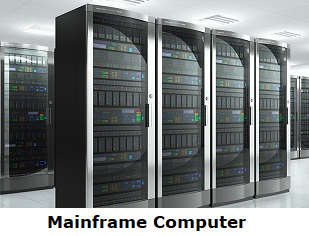 It is a medium machine made by connecting several units together. Mainframe computer are generally used in big organization and government sector for large scale processing.
It is a medium machine made by connecting several units together. Mainframe computer are generally used in big organization and government sector for large scale processing. In India railway reservation, airline reservation, are done with the help of mainframe computer. It can support all kind of high level languages. It can support all numbers of terminal up to 100 or more. It is capable of handling all types of problems whether it is scientific or commercial. It has sigh speed memory which enables it to process applications faster than mini and micro computers.
The UNIVAC I (Universal Automatic Computer I) was the first commercial mainframe computer produced in the United States in 1951.
Mini Computer:
They are like small mainframe computers. They are consisted of a few separated units connecting together. They can process information at the rate of 4 million bits per second. They are not so powerful as mainframe computers. They are generally applied to perform smaller works in commercial or government organization.
Personal Computer:
 Micro computers are also known as personal computers are the smallest general purpose computers. It contains a small CPU which is also known as Central Processing Unit or micro processor.
Micro computers are also known as personal computers are the smallest general purpose computers. It contains a small CPU which is also known as Central Processing Unit or micro processor. A micro processor is a complete CPU inside a single chip. Micro computer are being manufactured at large scale as compared to others. Micro computers are easy to handle so they are continuously used in different sectors like business, engineering, school and for entertainment etc.
Personal computers are used to do the jobs which does not required critical computing. Micro computer can be used by a single user at a time so that it is named as personal computer.
Features of a Computer:
- Today computes are the backbone of each and every business. It is also used as an entertainment gadget. The most common features of a computer that makes it a powerful device are listed below.
- A computer is a very fast device. It can do a job in a few minutes for which a human being can take an hour. The quick services we expect from bank, railway reservation, airline reservation, at the grocery store, at stoke exchange and while using Internet we are dependent on the speed of the computer. A Super computer is capable of performing 100 quadrillion floating-point operations per second.
- Accuracy of a computer is consistently high and the degree of accuracy of a particular computer depends on its hardware. A particular computer has same degree of accuracy for each calculation it performs. A computer does not create any error while calculation itself. The errors occurred in a calculation are caused by the humans. The reason may be that the programmer has written the wrong code for calculation based application or software or it may be possible that the data which is provided by the user to the computer is not right or insufficient.
- Reliability of a computer is extremely high. We can completely rely on a computer to get a fine and accurate result if the user provides right and sufficient data to the computer.
- A computer is free from physical and mental tiredness and lack of concentration. A computer can work for hours without stopping. If a computer is ordered to process ten millions of data then it will calculate each of them with same speed and it will provide output of each data with same accuracy.
- A computer has a wide area of its application. It can be used in companies for data processing, in daily life for entertainment, scientific application and in education.
- A computer is capable of storing a huge amount of data. We can store data of any size in a computer at any time and we can also retrieve it any time very quickly.
- A computer can store and recall any amount of information whenever it requires. Every piece of information can be retained as long as desired by the user and can be recalled as and when required. Even after several years, the information recalled will be as accurate as on the day when it was fed to the computer. A computer forgets or looses certain information only when it is asked to do so. So it is entirely up to the user to make a computer retain or forget particular information.
Limitation of a Computer:
- A computer has no I.Q. (Intelligence Quotient). a computer can perform tasks that a human can. The difference is that it performs these tasks with unthinkable speed and accuracy. It has no intelligence of its own. A computer has to be instructed to do these tasks. Hence only a user can decides what task a computer will perform.
- A Computer has no feelings or emotions because they are machines. We make our decisions based on our feelings, taste, knowledge, and experience in our daily life but a computer cannot take a decision itself. Decisions of a computer are based on the instruction we give them in form of codes.
- A virus can affect the performance of a computer. Sometimes they can also destroy our computers.
- A computer cannot be operated without electricity.
Application of a Computer:
- Computers are used for playing games, listing music and watching movies. It is also used to create movies and to make drawings.
- Today computers are used in school for teaching, doing mathematical calculations and making computer projects.
- In banking sector computers are used to store information of its account holders, it is also used to keep record of cash deposit and withdrawal it is also used by the ATM.
- At railway stations and airports computers are used to check seat availability and for seat booking. It is also used to see timings trains and aeroplanes and to see the arrival and departure of trains and aeroplanes.
- In business, computers are used to prepare documents, letters and to print them. They also help to store records of its all employees and other details of the business. It is also used to send E mails to business colleagues.
- Now computers are used to design magazines, newspapers, books and advertisements, they are also used for design clothes, preparing blue prints of a buildings and for auto mobile designing.
- Computers are used in administration at a large scale for handling of all kind of works of administration.
- Computers are used for desktop publication.
- Different types of computers are used by the scientists for their different projects handling.
- In Defence computers are used for designing weapons, controlling their functions and launching missiles and to store records of criminals. It is also used to connect soldiers with the operating base.
- Computers are used in communication system.
